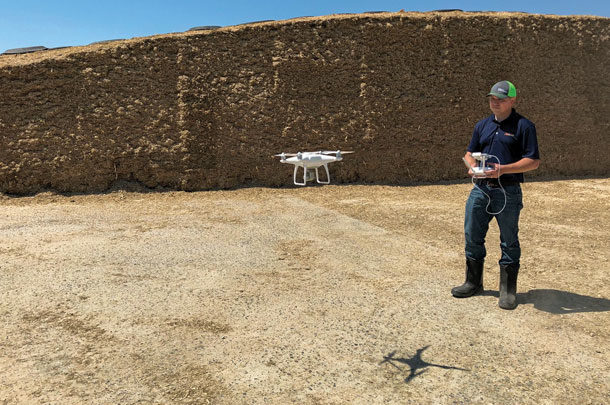Measuring and calculating the amount of silage or other feedstuffs stored in piles, bunkers or pits can be a challenge.
If we are lucky and the stars align, they would be built perfectly square and level, but we all know that perfect rarely happens in farming and ranching. We’ve come a long way, and technologies, such as drones, have advanced and improved calculations so we can become more accurate and efficient in many areas in agriculture, including silage inventories.
Before advancements in technology and accessibility to drones, I would show up to your farm with a measuring wheel, tape measure and some creative farm math. Let’s say your neighbor, we’ll call him Jerry for this example, stops by. Jerry just happens to be exactly 6 feet tall, and we have him stand in front of the face of the pile, and it looks to be about three times as tall as Jerry.
Then we use a little geometry from middle school and square the ramps off by cutting them in half, hoping that it perfectly squares up the pile because every pile and ramp gets built at the recommended 3-to-1 slope, right? Now we have the height of three times the height of Jerry, and with a simple calculation we now have total cubic volume. Or, at least that will be close, but what happens as Jerry ages and maybe shrinks a few inches, or if we made a mistake and wrote down the wrong number or forgot to reset the measuring wheel (and let’s face it, for safety’s sake Jerry shouldn’t be standing close to the pile face anyway)?
To help us better understand, let’s put together a pile that is 90 feet wide by 200 feet long and 15 feet high with a density of 15 pounds dry matter (DM) per cubic feet (CF). Considering the ramps and dome height and/or width, a pile that size will hold about 922 DM tons or 2,635 as-fed tons at 35% DM. If our measurements were off and that pile was only 14 feet high, it would only have 850 DM tons or 2,425 as-fed tons. That’s a 72 DM ton or 210 as-fed ton difference. Is it worth knowing if you are going to be short on feed so you can adjust to stretch silage longer?
What about farms that use chopper numbers and field estimates? How accurate do you think that is? What if the equipment hasn’t been calibrated lately or calibrated correctly at all? What if somehow loads were missed, or information from field to field was not written down? What about silage that goes through the chopper but misses the trucks and wagons, or blows out going down the road?
If there are scales back at the farm, then each load can be weighed and totaled. That is a great option, as long as each load actually gets recorded and nothing is missed. Also, each truck or tractor needs to come back over the scale after they unload so their weight alone can be subtracted from the initial load. If you have an excellent process and system for keeping records this way, that’s fantastic, but it may not be feasible for everyone.
You also need to consider shrinkage. Do you take 10% off for shrinkage? What if the farm has an excellent pack, is speedy and has great coverage, does not open the pile up for a few months and follows every stored fermented-forage rule in the books, could they maybe have less than 10% shrink?
For realists though, what about farms that need to let the pile sit open overnight or for a few days during harvest or maybe never gets covered after finishing? What about the farm that does not have enough packing weight or time? It has been noted that an average operation in the Midwest, for example, will have 14% shrinkage by the end of feedout of that pile. For many operations, if Mother Nature gets in the way during harvest and management of the stored forage is subpar, shrinkage of 20% to 50% of the DM can result. On average, 15% to 20% shrinkage is more common for well-managed dairy and beef farms and ranches.
With so many questions, variables and what-if scenarios, what can we do to stop relying on estimates and guesswork to calculate accurate inventories? Years ago, satellite imagery brought us the capability to look at our land, farms and even our silage piles to show dimensions and elevations. But there were still issues, as the images were still not exact and could be off by 3 to 6 feet, or more. As demonstrated in the equation above, just being off by a foot can result in running out early.
The next big advancement in technology for the agriculture industry has been drones. Drones came onto the scene in 2006 when the Federal Aviation Administration (FAA) finally cleared them for private recreational use, but it wasn’t until 2010 that consumer drones really started hitting the market, and it took several more years until more affordable drones were widely available to your average consumer.
Today, we have access to easily order a drone for almost anything. In the agriculture industry, they are being used to scout crops for diseases and insect infestations, take aerial farm pictures and check cattle out on the range. They can even identify cattle through facial recognition and/or body markings, and apply pesticides, fungicides and herbicides from sprayer applicators. Drones have many possibilities in the agriculture industry.
As drone technology has improved, so have the programs and applications that go along with them. Cloud computing services – services and support not directly managed by the user where the service and/or application is provided through internet, cell data or satellites – has become a booming industry for the past decade and has increased even more during the COVID-19 pandemic.
There are applications that can be used to help the everyday farmer and rancher better estimate certain on-farm feeds and ingredients, which can be more accurate than guessing or hoping the piles were measured correctly. There are now many cloud computing service providers and application manufacturers that have the capability to assist with volumizing piles. Over the past few years, several providers have brought more accurate and faster programs to measure silage piles. As much of this technology is new, it can be expensive to purchase and maintain renewals. Also, the FAA requires commercial sites, including agriculture operations, farms and ranches, to obtain a remote pilot certificate and, in many cases, to be insured.
Today’s programs to help with silage inventories can have a drone autonomously fly a feed pad, take a certain pre-determined number of images, then send those images to a cloud computing server that stitches the imagery together to create a 3D model of your feed pad. Once that 3D model has been stitched together, the user can go into the application and volumize the silage piles that results in a 3D layout of that silage and therefore, total cubic volume. These 3D models are very accurate as they take into account every curve, bend, dip and rise.
Have you ever built or tried to measure a silage pile that was misshaped, crooked or bent around a building or another pile? Well, these programs run elevations based upon pixels in the images which can equate to one pixel being anywhere from 1/16 to 1/4 of an inch of surface area on top of whatever the drone is being flown over and pictured. That means there could be billions to trillions of measurements taken on one small silage pile. So when we talk about being off by a few inches or maybe feet when it comes to measuring by hand, or guessing, drone technology can be accurate to mere fractions of an inch when measuring cubic volume of feed piles, so you know exactly how much you have in your silage inventory.













